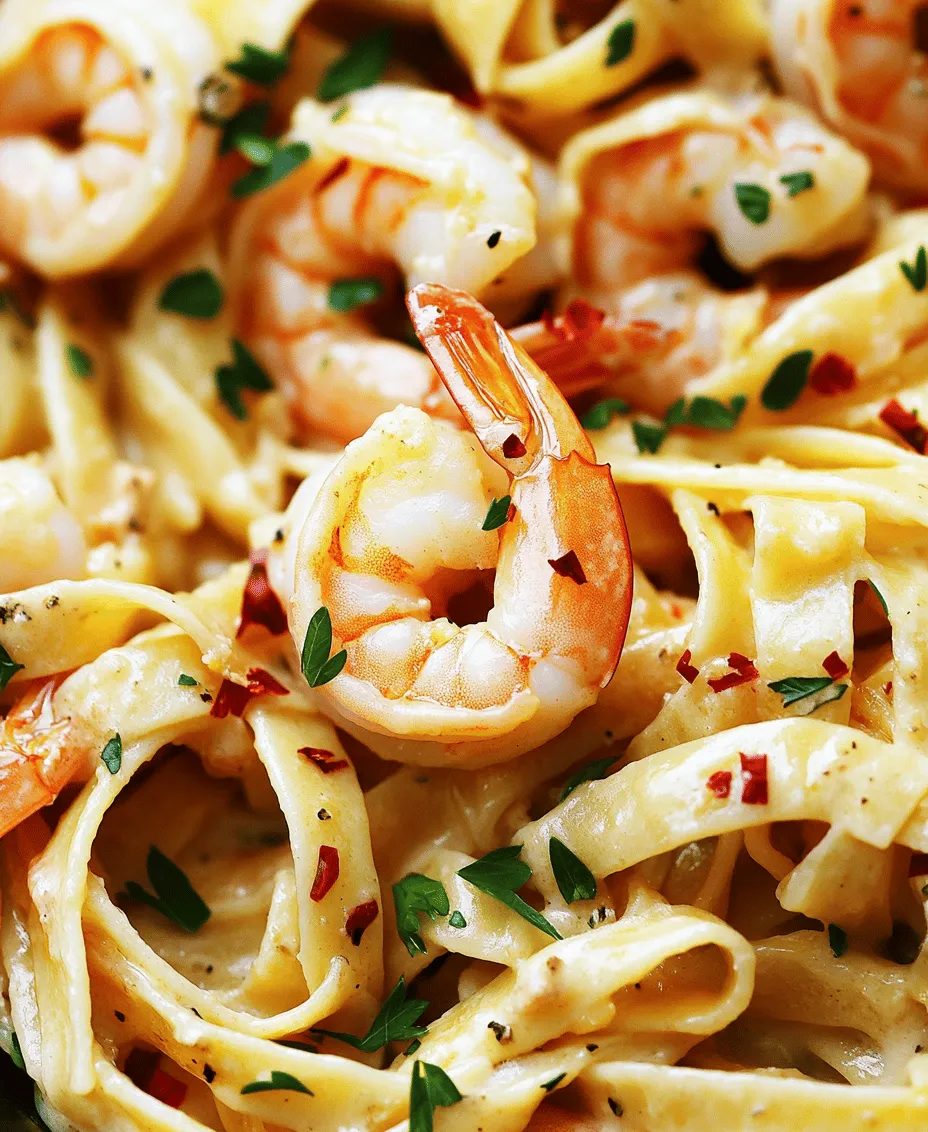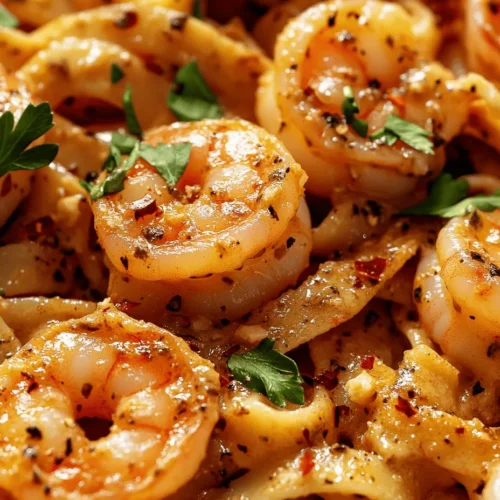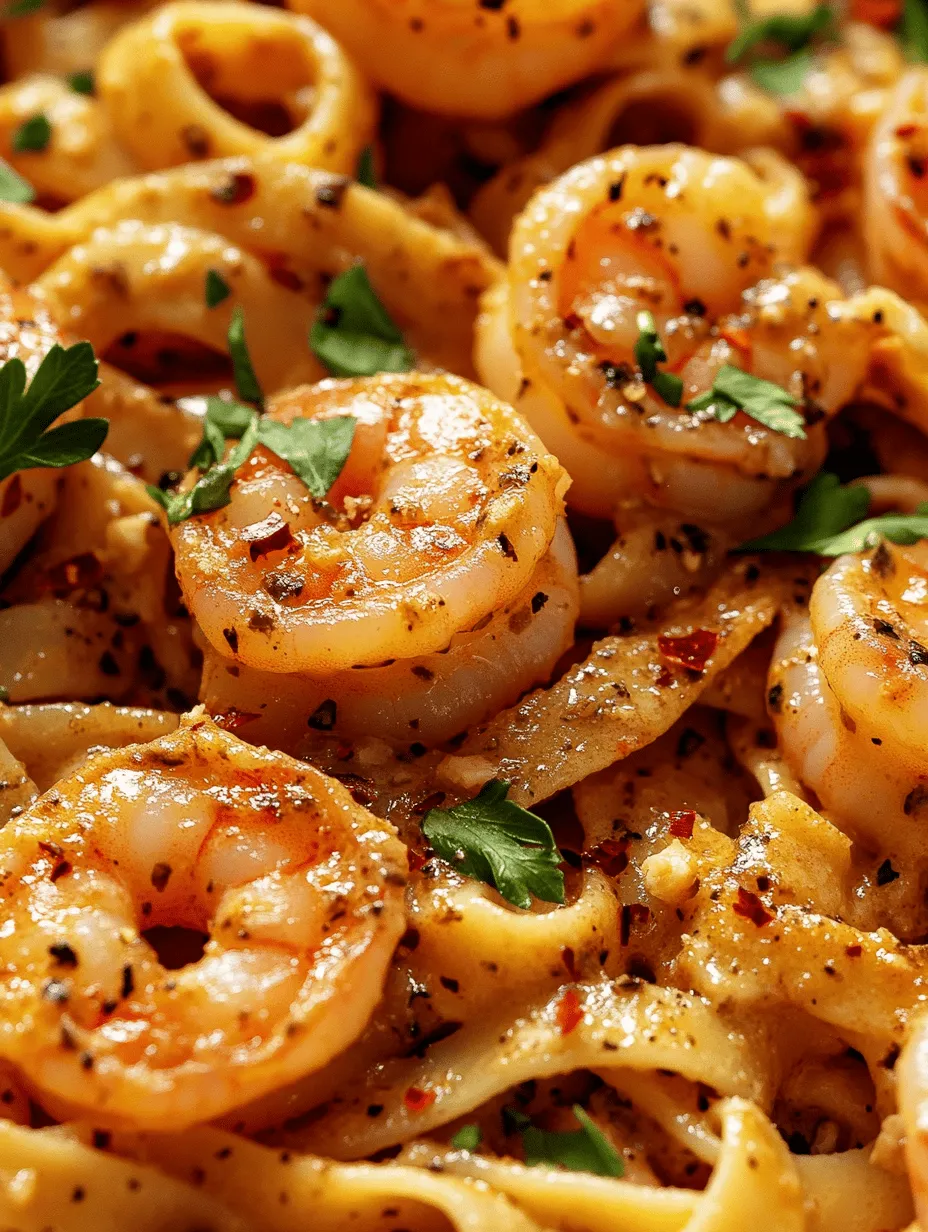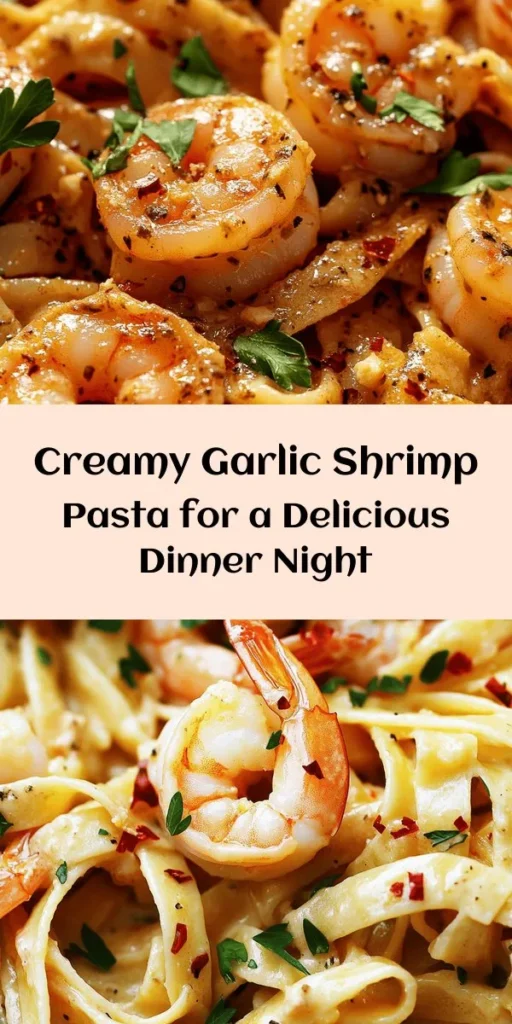Creamy Garlic Shrimp Pasta is a delightful dish that encapsulates the essence of Italian cuisine, combining rich flavors and satisfying textures in every bite. This dish brings together the aromatic warmth of garlic, the luscious creaminess of a well-crafted sauce, and succulent shrimp, all perfectly tossed with al dente fettuccine pasta. Not only is this recipe remarkably quick to prepare, making it an ideal choice for busy weeknight dinners, but it also serves as an impressive meal that can elevate any gathering. Whether you’re cooking for family, friends, or a romantic dinner for two, Creamy Garlic Shrimp Pasta is sure to wow your guests and leave them asking for seconds.
In this article, we will delve into the details of this delicious recipe, exploring the key ingredients that make it so special and providing insights into the preparation steps that will ensure your dish turns out perfectly every time. From understanding the role of each ingredient to mastering the cooking techniques, you’ll gain all the knowledge needed to create this culinary masterpiece in your own kitchen.
Understanding the Ingredients
Overview of Fettuccine Pasta
Fettuccine, a flat, thick type of pasta made from egg and flour, serves as the perfect vessel for this creamy sauce. Its broad surface area allows for better adherence to sauces compared to thinner varieties, ensuring that every bite is filled with flavor. When cooked properly, fettuccine has a delightful chewiness that complements the tenderness of the shrimp and the richness of the sauce.
The Role of Shrimp in the Dish
Shrimp is a star ingredient in this recipe, known for its sweet, briny flavor and tender texture. When cooked correctly, shrimp adds a delightful contrast to the creamy sauce and pasta. Not only is shrimp delicious, but it is also a nutritious protein source, rich in omega-3 fatty acids and low in calories. When selecting shrimp for this dish, consider using fresh or frozen shrimp that are peeled and deveined. This will save you time in preparation and enhance your cooking experience.
Importance of Garlic and Its Benefits
Garlic is the backbone of this dish, infusing it with a bold flavor that is both aromatic and savory. Beyond its flavor, garlic has numerous health benefits, including its ability to boost the immune system, reduce inflammation, and promote heart health. For this recipe, using fresh garlic cloves is recommended, as they provide a more robust flavor compared to pre-minced garlic options. The key to unlocking garlic’s full potential is to sauté it until fragrant but not burnt, allowing its natural sweetness to develop.
The Creamy Base: Heavy Cream and Chicken Broth
The creamy sauce that envelops the pasta and shrimp is a combination of heavy cream and chicken broth. Heavy cream contributes a luscious richness and velvety texture, while chicken broth adds depth and savory flavor. Together, they create a harmonious balance that elevates the dish. For a lighter version, you can substitute half-and-half or a lower-fat cream, but keep in mind that this may alter the overall creaminess.
Adding Depth with Parmesan Cheese
Parmesan cheese is a classic addition to creamy pasta dishes, providing a nutty flavor and enhancing the overall richness of the sauce. Freshly grated Parmesan is preferable, as it melts more smoothly and adds a touch of elegance to the dish. Additionally, it can be used as a garnish for serving, adding a finishing touch that delights the eyes and palate.
The Use of Olive Oil and Butter
In this recipe, both olive oil and butter play essential roles in building flavor. Olive oil is used for sautéing the shrimp, imparting a fruity richness, while butter is added to the garlic sauce for a luxurious texture. This combination not only enhances the overall taste but also contributes to the dish’s silky mouthfeel.
Spice It Up: Red Pepper Flakes
For those who enjoy a hint of heat in their dishes, red pepper flakes are the perfect addition. Just a pinch can elevate the flavor profile of the creamy garlic sauce, providing a subtle kick that complements the richness of the cream and the sweetness of the shrimp. Adjust the amount of red pepper flakes to suit your spice tolerance; you can always add more, but it’s difficult to tone down the heat once it’s in the dish.
Flavor Enhancements: Salt and Pepper
Seasoning is crucial to achieving the best flavor in any dish, and this Creamy Garlic Shrimp Pasta is no exception. Salt and freshly ground black pepper should be added throughout the cooking process to enhance the natural flavors of the ingredients. Be mindful of the salt content in your chicken broth and Parmesan cheese while seasoning, as both can contribute to the overall saltiness of the dish.
Importance of Fresh Herbs for Garnish
Fresh herbs add a burst of color and freshness to your pasta dish, making it not only taste better but also look appetizing. Parsley is a popular choice, as its bright green color and mild flavor contrast beautifully with the creamy sauce. Chopped basil or chives can also be used for a different flavor profile. Adding fresh herbs just before serving gives a vibrant touch and elevates the presentation of the dish.
Preparation Steps Explained
Cooking the Pasta to Perfection
Start by bringing a large pot of salted water to a boil. The water should be as salty as the ocean, which helps to season the pasta as it cooks. Once the water is boiling, add the fettuccine and cook according to the package instructions until al dente, typically about 8-10 minutes. Stir occasionally to prevent sticking. The goal is to achieve a firm yet tender texture that will hold up well once combined with the sauce.
The Science of Al Dente
Cooking pasta to al dente means that it is cooked just enough to retain a firm bite when chewed, which is essential for the overall texture of the dish. Al dente pasta will continue to cook slightly after being drained and mixed with the sauce, so it’s advisable to undercook it by about a minute according to the package instructions. This technique ensures that the pasta will not become mushy once combined with the creamy sauce.
Importance of Reserving Pasta Water
Before draining the pasta, be sure to reserve a cup of the starchy pasta water. This water is a culinary gem, as it contains starch that helps to thicken the sauce and bind it to the pasta. When you combine the sauce and pasta, you can use this reserved water to adjust the consistency of the sauce, ensuring it clings perfectly to every strand of fettuccine.
Sautéing the Shrimp
In a large skillet, heat a combination of olive oil and butter over medium-high heat. Once heated, add the shrimp in a single layer, being careful not to overcrowd the pan. Sauté the shrimp for about 2-3 minutes on each side until they turn pink and opaque. The key here is to cook the shrimp just until they are done, as they can become rubbery if overcooked.
Choosing the Right Shrimp
When selecting shrimp for your dish, consider the size and type. Large shrimp, commonly known as jumbo shrimp, are ideal for this recipe as they provide a meaty bite and are visually impressive when plated. Fresh shrimp is preferable, but if using frozen, ensure they are fully thawed and patted dry before cooking to achieve the best texture.
Key Techniques for Cooking Shrimp
The best technique for perfectly cooked shrimp is to avoid constant stirring. Place the shrimp in the skillet without moving them for the first minute to allow a nice sear to develop. Once they begin to turn pink, flip them to cook the other side. Remember that shrimp cook quickly, so keep a close eye on them to avoid overcooking.
Crafting the Garlic Sauce
Once the shrimp are cooked, remove them from the skillet and set them aside. In the same skillet, add more butter and a generous amount of minced garlic. The residual heat from the pan will begin to sauté the garlic, releasing its fragrant aroma.
The Art of Sautéing Garlic
Sautéing garlic requires attention, as it can burn quickly and turn bitter. Stir the garlic frequently and watch for it to turn golden brown—this is when it’s at its best flavor. Typically, this process takes about 30 seconds to a minute, depending on the heat of the skillet. Once the garlic is fragrant and just starting to turn golden, it’s time to move on to the next step.
Managing Heat to Avoid Burnt Garlic
If you notice that the garlic is browning too quickly, reduce the heat to medium or medium-low to prevent burning. Burnt garlic can ruin the flavor of your dish, so it’s crucial to find the right balance of heat to achieve a beautiful golden hue without going too far.
Combining Cream and Broth
After the garlic is perfectly sautéed, pour in the heavy cream and chicken broth, stirring to combine. This mixture will create the luscious base for your sauce. Bring the mixture to a gentle simmer, allowing it to reduce slightly, which thickens the sauce and enhances the flavors.
Achieving the Perfect Creamy Consistency
As the sauce simmers, you will notice it starting to thicken. The cream will create a rich, velvety texture, while the chicken broth adds depth. If you find the sauce is too thick, you can add some reserved pasta water to reach your desired consistency. Conversely, if it is too thin, allow it to simmer a little longer to reduce.
Understanding Sauce Thickness
The thickness of your sauce is crucial for the overall dish; it should coat the pasta without being overly runny. Aim for a consistency that clings to the fettuccine while allowing the flavors to shine through. The right thickness can also be achieved through the addition of grated Parmesan cheese, which not only adds flavor but also helps to thicken the sauce further.
The Final Assembly: Bringing It All Together
After the sauce has reached the desired thickness, return the cooked shrimp to the skillet, followed by the drained fettuccine. Toss everything together gently, ensuring that the pasta is well coated in the creamy garlic sauce. If needed, add more reserved pasta water to help bind the sauce and pasta together.
This harmonious combination of flavors and textures will culminate in a dish that is not only visually appealing but also a true comfort food experience. Your Creamy Garlic Shrimp Pasta is almost ready to be served, and the aroma wafting through your kitchen will surely entice anyone nearby.
In the next part of this article, we will explore tips for achieving the best results and answer some common questions about this delectable recipe. Stay tuned to learn how to perfect your culinary creation!

Ensuring Even Coating of Pasta
Once your pasta is cooked al dente, it’s crucial to ensure that every strand is evenly coated with the creamy garlic sauce. Start by adding the drained pasta directly into the skillet with the sauce. Toss the pasta gently but thoroughly, allowing it to absorb the flavors of the sauce. If you find the pasta is sticking together, a splash of reserved pasta water can help loosen it up and promote better coating. This starchy water not only enhances the sauce’s consistency but also ensures that the sauce clings beautifully to the pasta, creating that rich, creamy texture we all crave.
Adjusting Sauce Consistency
Depending on your preference, you may want to adjust the sauce’s consistency. If the sauce appears too thick, gradually add more pasta water, stirring continuously until you achieve your desired creaminess. On the other hand, if it’s too thin, allow it to simmer for an additional couple of minutes over low heat, which will help thicken the sauce. Remember, the goal is a luscious, creamy texture that perfectly coats your pasta without being overly runny.
The Finishing Touch: Adding Shrimp and Garnish
Once the pasta is dressed in the creamy sauce, it’s time to introduce the shrimp. If your shrimp are cooked, simply fold them into the pasta, allowing their flavor to mingle with the sauce as you toss gently. If you’re starting with raw shrimp, ensure they are cooked through and pink before mixing them in. The heat from the pasta will warm the shrimp without overcooking them, keeping them tender and juicy.
For the final garnish, consider a sprinkle of freshly chopped parsley or basil. This not only adds a pop of color but also freshens up the dish, enhancing its aromatic profile. A light dusting of grated Parmesan cheese can also elevate the flavor, making each bite irresistible.
Serving Suggestions
Ideal Pairings with Creamy Garlic Shrimp Pasta
Creamy Garlic Shrimp Pasta is a versatile dish that pairs wonderfully with various accompaniments. A simple green salad dressed with a light vinaigrette can provide a refreshing contrast to the richness of the pasta. Additionally, crusty garlic bread or a loaf of artisan bread can be the perfect vehicle for savoring the leftover sauce at the bottom of your bowl.
Side Dishes that Complement the Meal
Consider serving your pasta with roasted vegetables, such as asparagus, bell peppers, or zucchini. These not only enhance the meal’s nutritional profile but also add vibrant colors and textures. A side of sautéed spinach or garlic green beans can also provide a delightful crunch and a fresh flavor that cuts through the creaminess of the pasta.
Wine Pairing Recommendations
To complement the rich flavors of Creamy Garlic Shrimp Pasta, a white wine is often the best choice. A crisp Sauvignon Blanc or a buttery Chardonnay can enhance the dish’s creaminess and balance the garlic’s robust flavor. Alternatively, a light Pinot Grigio can provide a refreshing contrast, making your dining experience even more enjoyable.
Presentation Tips for a Stunning Dish
Presentation is key when serving any dish, especially one as elegant as Creamy Garlic Shrimp Pasta. Start by twirling the pasta onto the plate using a fork or tongs, creating a visually appealing nest. Drizzle a bit of the creamy sauce over the top and garnish with freshly chopped herbs and a sprinkle of cheese. Adding a lemon wedge to the side not only brightens up the plate but also allows guests to add a splash of acidity if they wish.
How to Plate Pasta Like a Pro
To plate pasta like a professional, focus on height and shape. Use a pasta fork or tongs to twirl the pasta into a mound in the center of the plate. For added sophistication, consider using a ring mold to shape the pasta before removing it to create a clean, restaurant-style presentation. Ensure that there are no drips or splatters on the plate’s edge for a polished look.
Creative Garnishing Ideas
Besides herbs and cheese, think about adding a few extra garnishes for visual appeal and flavor. A sprinkle of red pepper flakes can introduce a delightful kick, while lemon zest can add a refreshing citrus note. Edible flowers or microgreens can also make for a stunning garnish, elevating the dish’s aesthetic value.
Nutritional Information
Breakdown of Calories and Macronutrients
A serving of Creamy Garlic Shrimp Pasta typically contains approximately 450-600 calories, depending on portion size and specific ingredients used. The macronutrient breakdown generally includes about 25-30 grams of protein (thanks to the shrimp), 60-80 grams of carbohydrates (from the pasta), and 15-25 grams of fat (primarily from the cream and butter). For those monitoring their calorie intake, adjusting the amount of cream or using low-fat alternatives can help reduce the overall calorie count.
Health Benefits of Key Ingredients
The key ingredients in this dish each come with their health benefits. Shrimp is an excellent source of lean protein and is rich in vitamins B12 and D, as well as selenium, which supports immune function. Garlic is known for its numerous health benefits, including anti-inflammatory properties and potential heart health benefits. Whole grain pasta can provide additional fiber and nutrients compared to traditional pasta, making this dish a more balanced option.
Considerations for Dietary Restrictions
For those with dietary restrictions, this recipe can be adapted to suit various needs. Gluten-free pasta can easily substitute traditional pasta, making it accessible for those with gluten sensitivities. Additionally, using dairy-free cream alternatives can accommodate lactose-intolerant individuals, while still delivering that creamy texture.
Exploring Variations
Vegetarian Alternatives
For a vegetarian twist on Creamy Garlic Shrimp Pasta, consider using sautéed mushrooms, zucchini, or artichoke hearts in place of shrimp. These ingredients can provide a satisfying texture and rich earthiness that complements the creamy sauce beautifully.
Substituting Shrimp with Plant-Based Proteins
If you want to replace shrimp with plant-based proteins, options like tofu, tempeh, or chickpeas can work well. Tofu absorbs flavors beautifully and provides a great source of protein. Simply sauté it until golden before adding it to the sauce.
Adding Vegetables for Extra Nutrition
Incorporating vegetables into your Creamy Garlic Shrimp Pasta not only boosts the nutritional value but also adds color and texture. Popular choices include spinach, peas, or broccoli. Adding these vegetables can enhance the dish’s flavor profile and make it more filling.
Popular Options: Spinach, Peas, or Broccoli
Spinach wilts down beautifully and adds a vibrant green color, while peas add a sweet pop that contrasts nicely with the creamy sauce. Broccoli provides a satisfying crunch and pairs well with the shrimp, making it a great addition. Simply cook these vegetables in the sauce for a few minutes until they are tender.
Experimenting with Different Pasta Types
Feel free to experiment with various types of pasta to find your favorite combination. Fettuccine, linguine, or even whole wheat pasta can provide different textures and flavors. Each type of pasta will slightly alter the experience of the dish, so don’t hesitate to try something new.
Gluten-Free Options
If you need a gluten-free option, there are numerous brands of gluten-free pasta available today. Look for ones made from brown rice, quinoa, or lentils for added nutritional benefits. The cooking method remains the same; just be mindful of the cooking times, as gluten-free pasta may require different boiling times.
Cultural Significance of Pasta Dishes
The History of Pasta in Italian Cuisine
Pasta has a rich history in Italian cuisine, believed to have originated from ancient civilizations. Its versatility and ability to pair well with various sauces have made it a staple in many households around the world. Creamy pasta dishes, in particular, reflect the Italian culinary tradition of combining simple ingredients to create something extraordinary.
Variations of Creamy Pasta Dishes Across Cultures
Creamy pasta dishes can be found in various forms across cultures, from the classic Alfredo in Italy to creamy carbonara and even Asian-inspired noodle dishes. Each variation showcases how different cultures adapt pasta to their local flavors and ingredients, creating unique and delicious interpretations.
How Creamy Garlic Shrimp Pasta Fits into Modern Dining
In today’s culinary landscape, Creamy Garlic Shrimp Pasta stands out not only for its flavor but also for its adaptability. It can be dressed up for formal occasions or enjoyed as a comforting weeknight meal, making it a beloved dish for many. Its ability to bridge casual and elegant dining makes it a staple in modern cuisine.
Conclusion
Creamy Garlic Shrimp Pasta is more than just a meal; it’s an experience that combines simplicity and elegance. Understanding the ingredients, preparation methods, and cultural context adds depth to this beloved dish. Whether you’re cooking for yourself or entertaining guests, this recipe ensures a satisfying culinary adventure that celebrates the joys of cooking and enjoying great food. With its rich flavors, delightful textures, and endless variations, Creamy Garlic Shrimp Pasta is a dish that everyone should have in their repertoire. Embrace the art of pasta making, and enjoy the process of creating something truly special in your kitchen.



